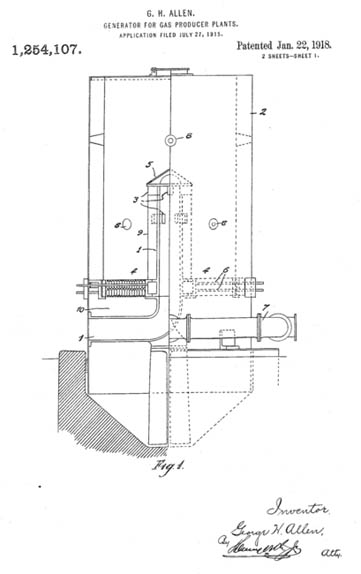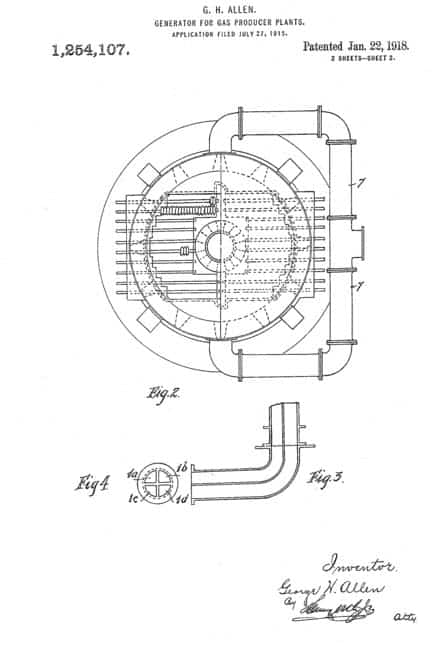Allen Gas Producer
Patents for Allen Gas Producer appeared in the USA and Australia; the USA patent date is 2 January 1918, and the latter is on 27 July 1914. George Hamilton Allen was an engineer from Collie, Western Australia, who died on Tuesday, 5 September 1922. He was born at Cossack in 1890, an old ghost town located 1,480 km north of Perth and 15 km from Roebourne in the Pilbara area of Western Australia.
The patents pre-date WWII fuel shortages and the many other gasifiers developed around this time. The Bunbury Herald and Blackwood Express reported on his death. “… he was an inventor of marked ability, the Allen Gas Producer being but one of his many achievements in engineering. It is well known that at the time of his death, he was engaged in constructing an engine that, had it been completed, would have revolutionised today’s engineering world.”
January 1918 and the latter on July 27, 1914. George Hamilton Allen was an engineer from Collie, Western Australia, who died on Tuesday, 5 September 1922. He was born at Cossack in 1890, which is an old ghost town located 1,480 km north of Perth and 15 km from Roebourne in the Pilbara area of Western Australia.
Allen Gas Producer Patents
The patents pre-date the WWII fuel shortages and the many other gasifiers developed around this time. The Bunbury Herald and Blackwood Express reported on his death. “he was an inventor of marked ability, the Allen Gas Producer being but one of his many achievements in engineering. At the time of his death, he was constructing an engine that, had it been completed, would have revolutionised today’s engineering world.”
I have yet to see an image of the gasifier and wonder if it ever went into production. In the US patent, the images above and the description is below:
Description
“Producer plants for the combustion of fuel therein have not been conducive to the even and complete consumption of the same. Since the outer surfaces only of the mass of fuel receive a sufficient supply of air. While the heart or interior of the mass obtains little or none, with obviously unsatisfactory results.
The object of this invention is, therefore, to overcome this objection. To provide means whereby the heart of the mass of fuel, as well as the outer surface, may receive the requisite supply of air. Previously heated, for the complete combustion and consumption of the fuel, in the process of generating gas, and thereby improving the quality of the gas produced and generally increase the efficiency of such appliances.
In carrying my invention into effect, I employ one or more air intakes, ducts or the like. To convey heated air to the heart or within the mass of the fuel. Such intakes or ducts are so situated that the air in its passage becomes heated and rises. Additional air inlets or ports, each fitted with a means of controlling its supply of air. They may also be provided in the wall or walls of the generating chamber’s outer shell in conjunction if desired.
Cylindrical
In my preferred form of construction, I utilise a cylindrical form of a shell or outer wall. The air intake or duct is formed, so it enters the generating chamber in the vicinity of the fire zone. It then rises centrally and to a convenient height therein. This centrally placed air-intake duct is preferable of tubular formation. It is formed or provided with ports or orifices for the delivery of the heated air that it conveys. As it terminates beneath the door through which the fuel is fed, it may have a conical-shaped end or be provided with a conical-shaped cover or the like for the prevention of fuel lodging thereon and the protection of its ports or orifices.”


